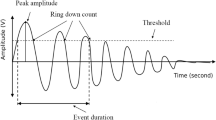Abstract
Working status of cutting tools (CTs) is crucial to the products’ precision. If broken down, it may lead to waste product. Condition monitoring and life prediction are beneficial to the manufacturing process. In this research, Logistic regression models (LRMs) and acoustic emission (AE) signal are used to evaluate reliability. Based on different conditions estimation, CTs are investigated to determine the best maintenance time. Based on experimental data analysis, AE and cutting force signals have better linear relationship with CT wearing process. They can be used to demonstrate CT degradation process. Frequency band energy is determined as characteristic vector for AE signal using wavelet packet decomposition. Two reliability estimation models are constructed based on cutting force and AE signals. One uses both signals, while the other uses only AE signal. The reliability degree can be estimated using the two models, independently. AE feature extraction and LRM can effectively estimate CT conditions. As it is difficult to monitor cutting force in a practical working condition, it is an effective method for CT reliability analysis by the combination of AE and LRM method. Experimental investigation is used to verify the effectiveness of this method.














Similar content being viewed by others
References
Alonso, F. J., & Salgado, D. R. (2008). Analysis of the structure of vibration signals for tool wear detection. Mechanical Systems and Signal Processing, 22(3), 735–748. doi:10.1016/j.ymssp.2007.09.012.
Bender, R., & Kuss, O. (2010). Methods to calculate relative risks, risk differences, and numbers needed to treat from logistic regression. Journal of Clinical Epidemiology, 63(1), 7–8.
Caesarendra, W., Widodo, A., & Yang, B.-S. (2010). Application of relevance vector machine and logistic regression for machine degradation assessment. Mechanical Systems and Signal Processing, 24(4), 1161–1171. doi:10.1016/j.ymssp.2009.10.011.
Chen, B., Chen, X., & Li, B. (2011a). Reliability estimation for cutting tools based on logistic regression model using vibration signals. Mechanical Systems and Signal Processing, 25(7), 2516–2537.
Chen, B. J., Chen, X. F., & Li, B. (2011b). Reliability estimation for cutting tool based on logistic regression model. Chinese Journal of Mechanical Engineering, 47(18), 158–164.
Dimla S, D. E. (2002). The correlation of vibration signal features to cutting tool wear in a metal turning operation. The International Journal of Advanced Manufacturing Technology, 19(10), 705–713.
Ding, F., He, Z. J., & Zi, Y. Y. (2009). Reliability assessment based on equipment condition vibration feature using proportional hazard model. Chinese Journal of Mechanical Engineering, 45(13), 89–94.
Heng, A., Zhang, S., Tan, A. C., & Mathew, J. (2009). Rotating machinery prognostics: State of the art, challenges and opportunities. Mechanical Systems and Signal Processing, 23(3), 724–739.
Huang, S. N., Tan, K. K., Wong, Y. S., de Silva, C. W., Goh, H. L., & Tan, W. W. (2007). Tool wear detection and fault diagnosis based on cutting force monitoring. International Journal of Machine Tools and Manufacture, 47(3–4), 444–451. doi:10.1016/j.ijmachtools.2006.06.011.
Jardine, A. K., Lin, D., & Banjevic, D. (2006). A review on machinery diagnostics and prognostics implementing condition-based maintenance. Mechanical Systems and Signal Processing, 20(7), 1483–1510.
Jemielniak, K., & Kwiatkowski, L. (1998). Diagnosis of tool wear based on cutting forces and acoustic emission measures as inputs to a neural network. Journal of Intelligent Manufacturing, 9(5), 447–455.
Kious, M., Ouahabi, A., Boudraa, M., Serra, R., & Cheknane, A. (2010). Detection process approach of tool wear in high speed milling. Measurement, 43(10), 1439–1446.
Liu, B. (2005). Selection of wavelet packet basis for rotating machinery fault diagnosis. Journal of Sound and Vibration, 284(3–5), 567–582. doi:10.1016/j.jsv.2004.06.047.
Martin, D. (1977). Early warning of bank failure: A logit regression approach. Journal of Banking and Finance, 1(3), 249–276.
Mill Data Set. (2007). BEST lab. UC Berkeley.
Peng, C. Y. J., Lee, K. L., & Ingersoll, G. M. (2002). An introduction to logistic regression analysis and reporting. Journal of Educational Research, 96(1), 3–14.
Peng, Z. K., & Chu, F. L. (2004). Application of the wavelet transform in machine condition monitoring and fault diagnostics: A review with bibliography. Mechanical Systems and Signal Processing, 18(2), 199–221. doi:10.1016/s0888-3270(03)00075-x.
Sharma, V. S., & Sharma, S. (2007). Cutting tool wear estimation for turning. Journal of Intelligent Manufacturing, 19(1), 99–108.
Sukhomay, P., & Heyns, P. (2009). Tool wear monitoring and selection of optimum cutting conditions with progressive tool wear effect and input uncertainties. Journal of Intelligent Manufacturing, 22(4), 491–504.
Venkatesh, K., & Mengchu, Z. (1997). Design of artificial neural networks for tool wear monitoring. Journal of Intelligent Manufacturing, 8(3), 215–226.
Wang, Z., & Wlofhard, L. (1996). Feature-filtered fuzzy clustering for condition monitoring of tool wear. Journal of Intelligent Manufacturing, 7(1), 13–22.
Xiaoyu, W., & wen, W. (2008). Design of neural network-based estimator for tool wear modeling in hard turning. Journal of Intelligent Manufacturing, 19(4), 383–396.
Yan, J., Ko, M., & Lee, J. (2004). A prognostic algorithm for machine performance assessment and its application. Production Planning and Control, 15(8), 796–801. doi:10.1080/09537280412331309208.
Yan, J., & Lee, J. (2005). Degradation assessment and fault modes classification using logistic regression. Journal of Manufacturing Science and Engineering, 127(4), 912–914.
Zhu, K., Wong, Y. S., & Hong, G. S. (2009). Wavelet analysis of sensor signals for tool condition monitoring: A review and some new results. International Journal of Machine Tools and Manufacture, 49(7–8), 537–553. doi:10.1016/j.ijmachtools.2009.02.003.
Zio, E. (2009). Reliability engineering, old problems and new challenges. Reliability Engineering and System Safety, 94(2), 125–141. doi:10.1016/j.ress.2008.06.002.
Acknowledgments
The work was supported by the Natural Science Foundation of China under Grant No. 51175057 and National Science and Technology Major Project of China under Grant No. 2013zx04012071.
Author information
Authors and Affiliations
Corresponding author
Rights and permissions
About this article
Cite this article
Li, H., Wang, Y., Zhao, P. et al. Cutting tool operational reliability prediction based on acoustic emission and logistic regression model. J Intell Manuf 26, 923–931 (2015). https://doi.org/10.1007/s10845-014-0941-4
Received:
Accepted:
Published:
Issue Date:
DOI: https://doi.org/10.1007/s10845-014-0941-4




